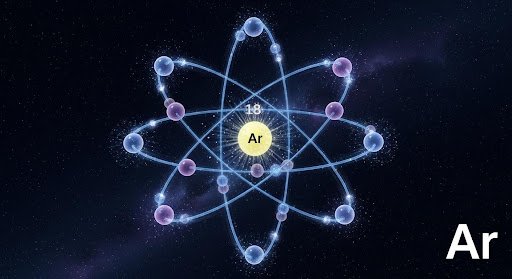Argon is a noble gas that plays a significant role in both scientific and industrial applications. But the question arises—is argon a gas, liquid, or solid – full breakdown? To understand this, we must examine the physical states of matter, argon’s behavior at various temperatures and pressures, and how it is used in everyday life.
In this detailed article, we’ll explore the different phases of argon, how it transitions between states, and why its gaseous form is most commonly used. We’ll also provide insight into its economic aspects like refilling costs, and its practical applications across industries.
What Is Argon?
Argon (chemical symbol Ar) is the third most abundant gas in the Earth’s atmosphere, making up about 0.93% by volume. It belongs to the noble gases group in the periodic table, which means it’s colorless, odorless, tasteless, and chemically inert under most conditions.
Argon’s atomic number is 18, and it has a full outer shell of electrons, which makes it extremely stable and unreactive. It is commonly obtained through the fractional distillation of liquid air and is widely used in welding, lighting, and electronics.
Is Argon a Gas, Liquid, or Solid?
The state of argon—whether it’s a gas, liquid, or solid—depends entirely on its temperature and pressure. Like all substances, argon can exist in all three states of matter under specific conditions.
1. Argon as a Gas (Most Common Form)
Under standard conditions (room temperature and atmospheric pressure), argon exists as a gas. This is the form in which it is most widely used.
- Melting Point: -189.3°C
- Boiling Point: -185.8°C
Since room temperature (~25°C) is far above its boiling point, argon naturally stays in a gaseous state at ambient conditions. This is why argon is typically sold, stored, and used in high-pressure gas cylinders.
Common uses of gaseous argon include:
- Shielding gas in welding
- Filling gas in light bulbs
- Inert environment for semiconductor manufacturing
- Preservation of sensitive documents or artifacts
For a deeper dive into the topic, check out this comprehensive guide:
is argon a gas, liquid, or solid – full breakdown
2. Argon as a Liquid
When cooled below its boiling point of -185.8°C, argon transitions into a liquid state. Liquid argon is colorless and non-toxic, but must be handled with extreme care due to its cryogenic nature.
Liquid argon is used in:
- Cryogenics and low-temperature physics research
- Medical and biological specimen preservation
- Large-scale gas supply systems where it can be evaporated on-demand
Due to the challenges of storage and transportation, liquid argon is primarily used in industrial-scale operations and research labs with specialized equipment.
3. Argon as a Solid
When further cooled below -189.3°C, argon becomes a solid. However, this state is rare outside of scientific experiments because it requires extremely low temperatures. Solid argon forms a face-centered cubic (FCC) crystal structure and has no commercial use in this form.
How Argon Transitions Between States
The transition of argon between solid, liquid, and gas involves physical processes:
- Solid to Liquid (Melting): At -189.3°C under standard pressure
- Liquid to Gas (Boiling): At -185.8°C under standard pressure
- Gas to Liquid (Condensation): Achieved by compression and cooling
- Gas to Solid (Deposition): Direct phase change under specific cryogenic conditions
These transitions are used in the production and transportation of argon in different industries. Most commonly, argon is stored and shipped as a high-pressure gas or cryogenic liquid, depending on the requirement.
Argon in Real-World Applications
Argon’s inertness makes it incredibly valuable across many industries:
1. Welding and Metal Fabrication
Argon acts as a shielding gas in TIG and MIG welding to prevent oxidation. Its stable atmosphere ensures cleaner and stronger welds, especially for stainless steel, aluminum, and titanium.
2. Electronics and Semiconductors
In microelectronics, argon creates inert environments necessary for the fabrication of high-purity components. It’s also used in plasma etching and sputtering.
3. Lighting and Displays
Argon is used to fill incandescent and fluorescent light bulbs to prevent the filament from oxidizing and improve bulb lifespan.
4. Medical and Laboratory Settings
Argon lasers are used in eye surgeries, and the gas is used in cryopreservation and chromatography.
Argon Refill and Supply Considerations
For users needing argon for welding or other purposes, refilling tanks is a regular operational task. The argon refill cost varies depending on tank size, gas purity, and supplier pricing.
Storage and Safety of Argon
While argon is non-toxic and inert, it is still a compressed gas and must be handled responsibly.
Key Safety Tips:
- Store cylinders upright and secured.
- Use proper regulators and gas flow meters.
- Ensure good ventilation; argon can displace oxygen and cause asphyxiation in confined spaces.
- Use protective gloves and eyewear when dealing with liquid argon to avoid cryogenic burns.
Environmental Impact of Argon
Unlike some industrial gases, argon has no ozone depletion potential and is non-reactive, making it environmentally benign. It is extracted from the atmosphere and does not produce harmful byproducts when used.
Conclusion
To answer the question, is argon a gas, liquid, or solid – full breakdown, argon can exist in all three states depending on temperature and pressure:
- Gas: Most common and widely used form
- Liquid: Used in cryogenics and industrial supply chains
- Solid: Rarely used, limited to scientific applications
In everyday scenarios and industrial processes, argon is most often used in its gaseous state due to convenience, effectiveness, and availability. Its unique characteristics make it a crucial component in welding, electronics, medical technologies, and beyond.
Whether you’re a welder, manufacturer, or researcher, understanding the phases of argon and its handling requirements is essential for safe and efficient use. For users interested in costs, sourcing, or applications, don’t forget to explore the latest on argon refill cost to optimize your supply chain.





